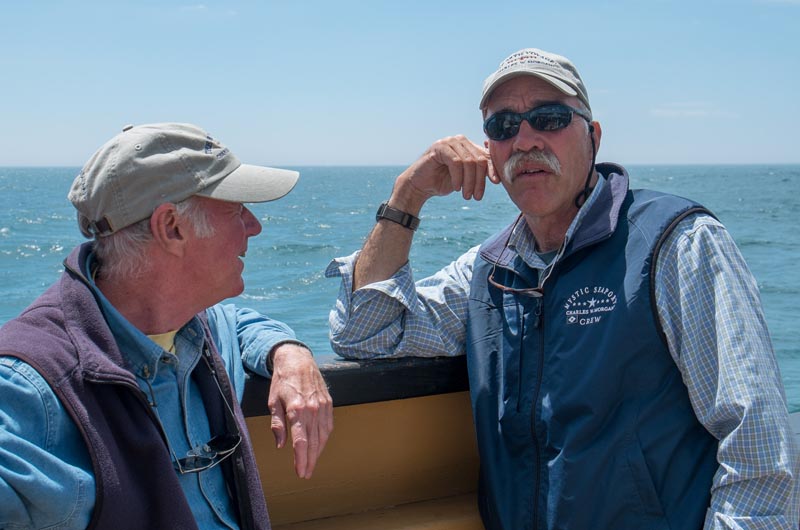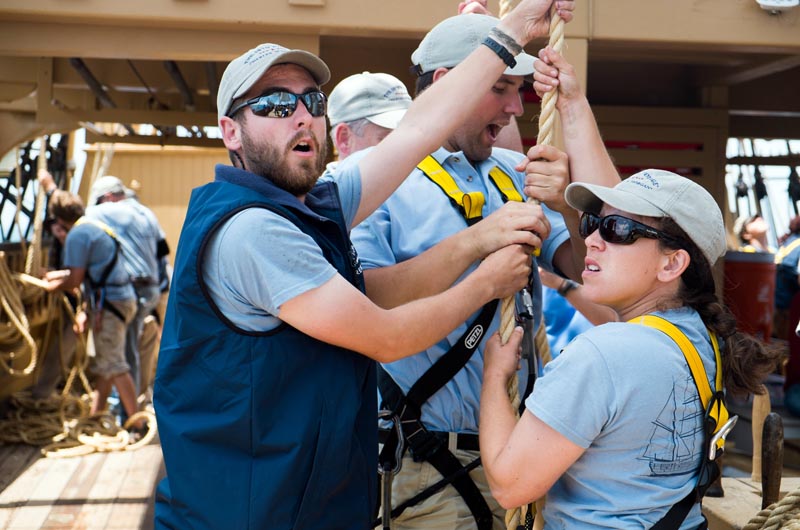For me, the ship came to life when she made what I will always remember as The Turn.
We were at the far end of Vineyard Sound early Wednesday afternoon, sailing to the east, about halfway between the Elizabeth Islands, which lay behind us, and Aquinnah ahead. Beyond the height of the bow of the whaling vessel Charles W. Morgan, we could see the Gay Head Light, rising like a tiny vertical dash above the mist. The light flashed red . . . white . . . red just where the sky began to waft from creamy white to blue.
We’d let go of the tug Sirius a few minutes before. From officers to crew, the commands and replies had echoed sharply back and forth between the bow and the middle of the ship, which lies a few ladder steps below. Chief mate Sam Sikkema had called out: “Haul back the towline. Fore-yard, sharp up. And heave! And heave! And heave! Make fast. . . .”
Astern of the tug, the towline had slapped into the water and had been snaked aboard. From the forward mast, a square sail had inched upward from a long wooden spar high above. The spar, known as a yard, had been set about 45 degrees off the center line of the ship, the best angle for the sail to draw the wind at that moment. The new sail caught the wind, and the whaler began to drive herself along, freed of the towline and all on her own. She heeled over a few degrees more than she had when the tug was doing some of the work, leading her from Newport toward the Vineyard in time to catch the tide.
It looked and sounded simple if I closed my eyes, drew on what I thought I knew about the fundamentals of sailing and thought only about the theory behind a given command and what the crew should do about it.
But over the course of the hazy morning and sparkling afternoon — across Rhode Island Sound, beneath Cuttyhunk, down the long Vineyard Sound straightaway to West Chop and around the corner into Vineyard Haven harbor — I’d hear the orders called and believe I understood what they meant. I’d watch the crew — assembled only one month before — race to one side of the ship, congregate along the length of a coarse and heavy line, grab hold and wrench themselves rhythmically in a great tug of war against the gear and forces aloft, as a leader cried, “Heave!”
Then I’d look up and see . . . nothing. All that knowledge, timing and muscle among officers and deckhands to do a thing a layman couldn’t pick up at all, no matter how carefully he looked across the vast latticework of spars and lines and blocks that towered into the blue sky above. So there was never any chance, really, that I was going to grasp what was about to happen through The Turn. “Prepare to tack,” called Mr. Sikkema from the forecastle. “Prepare to tack, aye!” came the response from the deck.
Slowly the whaleship began to bear into the wind, southward and to the right. I thought I would see the crew dash to unfasten lines and hear the hump and crackle of the foresails snapping through the wind. I looked up, also expecting to see the long yards and topsails begin to pivot from one angle above our heads to the same one on the other side of the ship.
Again, nothing. And then I realized what Capt. Kip Files, his officers and crew were doing. They were holding all the sails in place, allowing the Morgan to turn beneath them. And then, just as her wide, bluff bow swung through the breeze, the wind caught all the canvas at the same moment, stopping her cold and pivoting her almost on her own axis so that she was, in a moment, facing the direction from which she had just come — Elizabeth Islands now ahead, Aquinnah and the lighthouse suddenly astern.
A ship measuring 113 feet in length, with a beam of more than 27 feet, a draft of 17 feet — more than that of a Steamship Authority ferry — and carrying 120 tons of ballast had come as close to turning on a dime as anyone could imagine. The foresails, curving momentarily against the wind, had pushed the bow around and, at just the right moment, been sprung from the port side of the ship and reset on the starboard. The yards high above us had stopped the whaler, aided the start of the turn, then swung in unison from one angle to the other, with the square sails thundering briefly through the tack before filling again. Tears came to my eyes.
Where in the world, I wondered, is there another modern sailing ship and crew that can do that?
Up to now, the Charles W. Morgan had felt slightly bridled and agitated to me. Partially this had to do with the way the wind and sea caught her sails and hull as she did only some of the work to cross Rhode Island Sound behind the Sirius. Partly it had to do with the tug, whose diesel engine cried out hollowly from ahead as she pulled just insistently enough to make sure we reached Vineyard Sound at the start of the flooding tide at 11:30 a.m. Partly it had to do with the generator buzzing beneath our feet from somewhere down low in the ship.
And partly it had to do with me. Every minute that passed aboard the Morgan was a minute that would never come again. Once this cruise around the southern and eastern New England coastline ended in early August, she would return to Mystic Seaport, never to risk such a summer-long voyage again. How, I fretted, do you take in the final passage under sail of a National Historic Landmark, the last wooden whaling ship left to the United States, the oldest commercial vessel in the country? For a little while, I tried to be everywhere, taking down everything — the smokehouse smell of the lower decks, where the sunlight from the overhead gangways and grates swung back and forth in the darkness as the ship rose and fell in the swells. Then from amidships, the faraway sound of the spray as it hissed and sighed off the bow. Not for the first time did I find myself missing the whole experience in favor of a pointillist attempt to record it. Only this time, the experience and story would never happen again. I was losing the moment even as I was trying to see, feel, hear and remember it forever. Near the bow, I found Sean Bercaw of Falmouth, the second mate, who spent much of the passage relaying and repeating orders and making sure the crew was carrying them out properly. For 30 years, on and off, he has worked as a rigger, shipwright and educator aboard the Morgan at Mystic. But he has had wide experience sailing and commanding square riggers and other sailing vessels, and I asked how the Morgan had surprised him the most as she evolved this spring from a pierside artifact to a sailing ship once again.
“She’s very nimble,” he said. “Much more nimble than we anticipated. Maneuvering, tacking, turning. She has this little rudder — how can you control this big vessel with this small rudder? You think about it more, [the rudder is] not very long fore and aft, and it’s almost 12 feet long vertically. So there’s still a lot of surface area. She’s lean enough in the stern so the water can get in there so you can really direct it.”
He thought a moment, then said:
“It’s really easy to underestimate the wisdom of the ages. If you think about it, this vessel was used for 80 years. And if she was a total dog, they wouldn’t have used her for 80 years. They would have said it’s not worth it — throw it away.” The Morgan, he added, was built in seven months back in 1841, with a three-week strike stalling things in the middle of construction. “And we’ve spent [more than] five years restoring it. With modern tools. This was built with old hand tools in a little over six months.”
The Morgan as a whaling ship was actually designed to be several vessels in one — a hunter, tanker, factory ship and expeditionary ship, he said. As an officer whose job it was to make sure his crew was working together well, he marveled that, for most of a career spanning much of a century, “they operated it with a crew, most of whom often couldn’t speak the same language.”
As the Morgan rounded East Chop, a flotilla of catboats, cabin cruisers, schooners, catamarans and motor yachts swept around the point ahead of her, abreast and behind.
Aboard the 1903 steam yacht Cangarda, seated forward of the pilothouse with his wife Joan, was S. Bailey Norton Jr. of Edgartown, whose great-great uncle, Thomas A. Norton, had commanded the Morgan on her maiden voyage in 1841. The wooden fishing vessel Little Lady of Menemsha, belonging to Dennis Jason Jr., motored alongside Roann, an eastern-rigged dragger built in 1947 for Capt. Roy Campbell of Vineyard Haven, now an exhibit at Mystic but called from retirement to serve as an auxiliary vessel to the Morgan throughout her cruise. With family and friends, Nat Benjamin kept company in Charlotte, the wooden schooner he designed and built at the Gannon and Benjamin Marine Railway at the head of Vineyard Haven harbor.
As cannons fired from Martha’s Vineyard Shipyard and fire hoses sent jets of water arcing into the sun on either side of her bow, the Morgan dropped her sails and the tug came alongside her hip, pushing her forward. Ahead, on the pier where we would tie up at the Tisbury Wharf Company, I could see Ralph Packer in a light blue cap.
For weeks he had refused to help the Gazette tell the story about the many ways he and his companies along the Vineyard Haven waterfront had made this voyage possible: with the tugs Sirius and Thuban to tow her when needed, and with this wharf where the Morgan will be berthed during her visit. A minor point in the whole story, he had said, and not worth reporting.
Not quite true, I thought on deck. A few minutes before, Capt. Paul Bangs of the Sirius had sent Matthew Stackpole photos of the Morgan under sail. Mr. Stackpole, of West Tisbury, had served as ship’s historian and major gifts officer of the effort to rebuild the Charles W. Morgan at Mystic and send her out sailing once again. At the end of the message, Captain Bangs had written, “Thanks for letting us do this.” Mr. Stackpole looked down on Mr. Packer, the owner of the tug and wharf, and said: “As if we could have done it without him.”
With Sirius roaring and pushing on one side of the hull, and a Zodiac from Mystic pushing on the other, the Morgan turned once again on her axis. At her mooring, the length of the topsail schooner Shenandoah swept slowly by, just beyond the Morgan’s bowsprit, as the whaling ship rotated half a circle so that her loading side lay along the pier and her bow pointed seaward again. A few passengers expressed awe that the tug, the Zodiac and the Morgan could do so in such a small space.
I was less surprised. After all, only two hours before, I had seen and felt her do exactly the same thing on Vineyard Sound. Only that time she made The Turn all on her own.
View more photos of Charles W. Morgan sailing to Martha's Vineyard












Comments (10)
Comments
Comment policy »